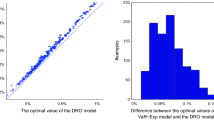Abstract
The portfolio selection problem is usually considered as a bicriteria optimization problem where a reasonable trade-off between expected rate of return and risk is sought. In the classical Markowitz model the risk is measured with variance, thus generating a quadratic programming model. The Markowitz model is frequently criticized as not consistent with axiomatic models of preferences for choice under risk. Models consistent with the preference axioms are based on the relation of stochastic dominance or on expected utility theory. The former is quite easy to implement for pairwise comparisons of given portfolios whereas it does not offer any computational tool to analyze the portfolio selection problem. The latter, when used for the portfolio selection problem, is restrictive in modeling preferences of investors. In this paper, a multiple criteria linear programming model of the portfolio selection problem is developed. The model is based on the preference axioms for choice under risk. Nevertheless, it allows one to employ the standard multiple criteria procedures to analyze the portfolio selection problem. It is shown that the classical mean-risk approaches resulting in linear programming models correspond to specific solution techniques applied to our multiple criteria model.
Similar content being viewed by others
References
D.E. Bell and H. Raiffa, Risky choice revisited, in: Decision Making: Descriptive, Normative and 162 W. Ogryczak / Linear programming model for portfolio selection Prescriptive Interactions, eds. D.E. Bell et al. (Cambridge University Press, Cambridge, 1988) pp. 99–112.
V. Chankong and Y.Y. Haimes, Multiobjective Decision Making(North-Holland, Amsterdam, 1983).
P.C. Fishburn, The Foundations of Expected Utility(Reidel, Dordrecht, 1982).
J.L. Gastwirth, A general definition of the Lorenz curve, Econometrica 39 (1971) 1037–1039.
M.G. Kendall and A. Stuart, The Advanced Theory of Statistics,Vol. 1: Distribution Theory (Griffin, London, 1958).
R.S. Klein, H. Luss and D.R. Smith, A lexicographic minimax algorithm for multiperiod resource allocation, Math. Programming 55 (1992) 213–234.
H. Konno and H. Yamazaki, Mean-absolute deviation portfolio optimization model and its application to Tokyo stock market, Manag. Sci. 37 (1991) 519–531.
M.M. Kostreva and W. Ogryczak, Linear optimization with multiple equitable criteria, RAIRO Rech. Op´er. 33 (1999) 275–297.
H. Levy, Stochastic dominance and expected utility: survey and analysis, Manag. Sci. 38 (1992) 555–593.
A. Lewandowski and A.P. Wierzbicki, eds., Aspiration Based Decision Support Systems-Theory, Software and Applications (Springer, Berlin, 1989).
E. Marchi and J.A. Oviedo, Lexicographic optimality in the multiple objective linear programming: the nucleolar solution, Eur. J. Opl. Res. 57 (1992) 355–359.
H. Markowitz, Portfolio selection, J. Fin. 7 (1952) 77–91.
A.W. Marshall and I. Olkin, Inequalities: Theory of Majorization and Its Applications(Academic Press, New York, 1979).
W. Ogryczak, Equitable multiple criteria programming, Technical Report TR 96–02 (223), Institute of Informatics, Warsaw University, Warsaw (1996).
W. Ogryczak and S. Lahoda, Aspiration/reservation decision support-a step beyond goal programming, J. Multi-Criteria Dec. Anal. 1 (1992) 101–117.
J.A.M. Potters and S.H. Tijs, The nucleolus of a matrix game and other nucleoli, Math. Oper. Res. 17 (1992) 164–174.
U. Segal, Order indifference and rank-dependent probabilities, J. Math. Economics 22 (1993) 373–397.
W.F. Sharpe, A linear programming approximation for the general portfolio analysis problem, J. Fin. Quant. Anal. 6 (1971) 1263–1275.
M.G. Speranza, Linear programming models for portfolio optimization, Finance 14 (1993) 107–123.
R.E. Steuer, Multiple Criteria Optimization-Theory, Computation & Applications(Wiley, New York, 1986).
Ph. Vincke, Multicriteria Decision-Aid(Wiley, New York, 1992).
G.A. Whitmore and M.C. Findlay, eds., Stochastic Dominance: An Approach to Decision-Making Under Risk (D.C. Heath, Lexington, MA, 1978).
A.P. Wierzbicki, A mathematical basis for satisficing decision making, Math. Modelling 3 (1982) 391–405.
M.E. Yaari, The dual theory of choice under risk, Econometrica 55 (1987) 95–115.
R.R. Yager, On ordered weighted averaging aggregation operators in multicriteria decision making, IEEE Trans. Sys. Man Cyber. 18 (1988) 183–190.
R.R. Yager and D.P. Filev, Essentials of Fuzzy Modeling and Control(Wiley, New York, 1994).
S. Yitzhaki, Stochastic dominance, mean variance, and Gini's mean difference, Amer. Econ. Rev. 72 (1982) 178–185.
M.R. Young, A minimax portfolio selection rule with linear programming solution, Manag. Sci. 44 (1998) 673–683.
Rights and permissions
About this article
Cite this article
Ogryczak, W. Multiple criteria linear programming model for portfolio selection. Annals of Operations Research 97, 143–162 (2000). https://doi.org/10.1023/A:1018980308807
Issue Date:
DOI: https://doi.org/10.1023/A:1018980308807




